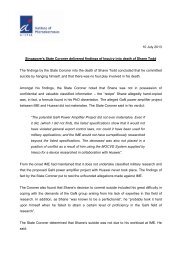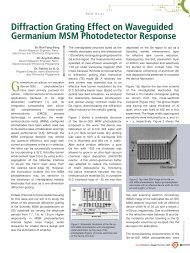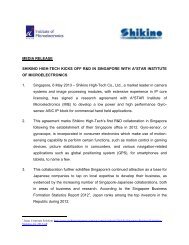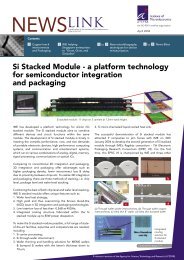taper couplers for coupling between laser and silicon waveguide ...
taper couplers for coupling between laser and silicon waveguide ...
taper couplers for coupling between laser and silicon waveguide ...
Create successful ePaper yourself
Turn your PDF publications into a flip-book with our unique Google optimized e-Paper software.
-1<br />
-1.5<br />
Coupling efficiency (dB)<br />
-2<br />
-2.5<br />
-3<br />
-3.5<br />
-3 -2 -1 0 1 2 3<br />
Tilting angle (degree)<br />
Fig. 9 Coupling efficiency vs. lateral tilting angle.<br />
Laser diode<br />
<strong>waveguide</strong><br />
Fig. 10 Light propagation from <strong>laser</strong> diode to <strong>silicon</strong> <strong>waveguide</strong> through <strong>taper</strong> coupler with 2 degree tilting.<br />
4. CONCLUSIONS<br />
In this paper a coupler is designed <strong>for</strong> <strong>coupling</strong> the light from <strong>laser</strong> diode to <strong>silicon</strong> <strong>waveguide</strong> with large alignment<br />
tolerances. The coupler has a pseudo vertical <strong>taper</strong>ed structure. Laterally, it has a linear <strong>taper</strong>. The input aperture is much<br />
larger than the size of the <strong>laser</strong> <strong>waveguide</strong> cross-section. The <strong>taper</strong>ed coupler provides single mode output <strong>and</strong> matches<br />
the mode propagation constant with that in <strong>silicon</strong> <strong>waveguide</strong>. The <strong>taper</strong>ed coupler is fabricated on the same substrate<br />
with the <strong>silicon</strong> <strong>waveguide</strong> through the <strong>silicon</strong> micro-fabrication process. The misalignment <strong>between</strong> the <strong>silicon</strong><br />
<strong>waveguide</strong> <strong>and</strong> <strong>taper</strong> coupler can be very small since this is controlled by high precision <strong>silicon</strong> optical bench patterning<br />
processes. The coupler relaxes the <strong>laser</strong> diode placement accuracies <strong>and</strong> eliminates the need <strong>for</strong> a <strong>coupling</strong> lens. Design<br />
Studies showed that the tolerance <strong>between</strong> the <strong>laser</strong> diode <strong>and</strong> <strong>taper</strong> coupler can be more than +/-4µm misalignment at x-<br />
y, <strong>and</strong> more than +/-2 degree tilting angle tolerance. The <strong>laser</strong> to <strong>silicon</strong> <strong>waveguide</strong> <strong>coupling</strong> tolerances is greatly<br />
improved <strong>and</strong> passive alignment <strong>for</strong> <strong>laser</strong> diode <strong>and</strong> <strong>silicon</strong> <strong>waveguide</strong> becomes possible. The technology is suitable <strong>for</strong><br />
functional integration <strong>for</strong> <strong>silicon</strong> photonics. Important results are summarized as followings:<br />
1. A <strong>taper</strong> coupler is designed <strong>for</strong> larger tolerance <strong>laser</strong> diode <strong>and</strong> <strong>silicon</strong> <strong>waveguide</strong> light <strong>coupling</strong>;<br />
2. The optimized structure can achieve -2dB <strong>coupling</strong> efficiency by simulation;<br />
3. With +/-4µm <strong>laser</strong> diode offset, the <strong>coupling</strong> efficiency varies only 3dB;<br />
4. +/-2 degree tilting at the <strong>laser</strong> diode varies the <strong>coupling</strong> efficiency by only 1dB.<br />
Proc. of SPIE Vol. 6899 689909-5













